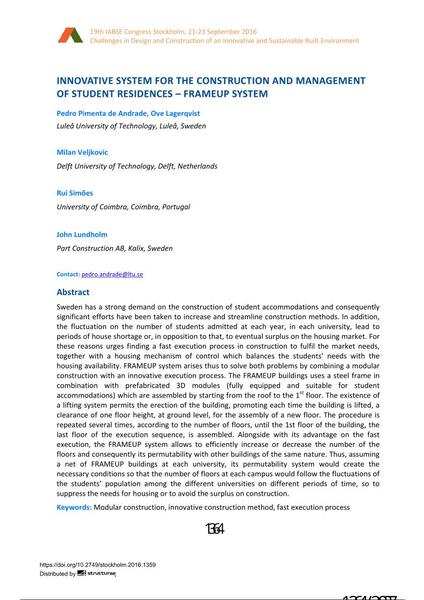Innovative System for the Construction and Management of Student Residences – Frameup System

|
|
|||||||||||
Bibliographic Details
| Author(s): |
Pedro António Pimenta de Andrade
(Luleå University of Technology, Luleå, Sweden)
Ove Lagerqvist (Luleå University of Technology, Luleå, Sweden) Milan Veljković (Delft University of Technology, Delft, Netherlands) Rui Simões (University of Coimbra, Coimbra, Portugal) John Lundholm (Part Construction AB, Kalix, Sweden) |
||||
|---|---|---|---|---|---|
| Medium: | conference paper | ||||
| Language(s): | English | ||||
| Conference: | IABSE Congress: Challenges in Design and Construction of an Innovative and Sustainable Built Environment, Stockholm, Sweden, 21-23 September 2016 | ||||
| Published in: | IABSE Congress Stockholm, 2016 | ||||
|
|||||
| Page(s): | 1364-1370 | ||||
| Total no. of pages: | 7 | ||||
| Year: | 2016 | ||||
| DOI: | 10.2749/stockholm.2016.1359 | ||||
| Abstract: |
Sweden has a strong demand on the construction of student accommodations and consequently significant efforts have been taken to increase and streamline construction methods. In addition, the fluctuation on the number of students admitted at each year, in each university, lead to periods of house shortage or, in opposition to that, to eventual surplus on the housing market. For these reasons urges finding a fast execution process in construction to fulfil the market needs, together with a housing mechanism of control which balances the students’ needs with the housing availability. FRAMEUP system arises thus to solve both problems by combining a modular construction with an innovative execution process. The FRAMEUP buildings uses a steel frame in combination with prefabricated 3D modules (fully equipped and suitable for student accommodations) which are assembled by starting from the roof to the 1st floor. The existence of a lifting system permits the erection of the building, promoting each time the building is lifted, a clearance of one floor height, at ground level, for the assembly of a new floor. The procedure is repeated several times, according to the number of floors, until the 1st floor of the building, the last floor of the execution sequence, is assembled. Alongside with its advantage on the fast execution, the FRAMEUP system allows to efficiently increase or decrease the number of the floors and consequently its permutability with other buildings of the same nature. Thus, assuming a net of FRAMEUP buildings at each university, its permutability system would create the necessary conditions so that the number of floors at each campus would follow the fluctuations of the students’ population among the different universities on different periods of time, so to suppress the needs for housing or to avoid the surplus on construction. |
||||
| Keywords: |
Modular Construction innovative construction method fast execution process
|
||||

